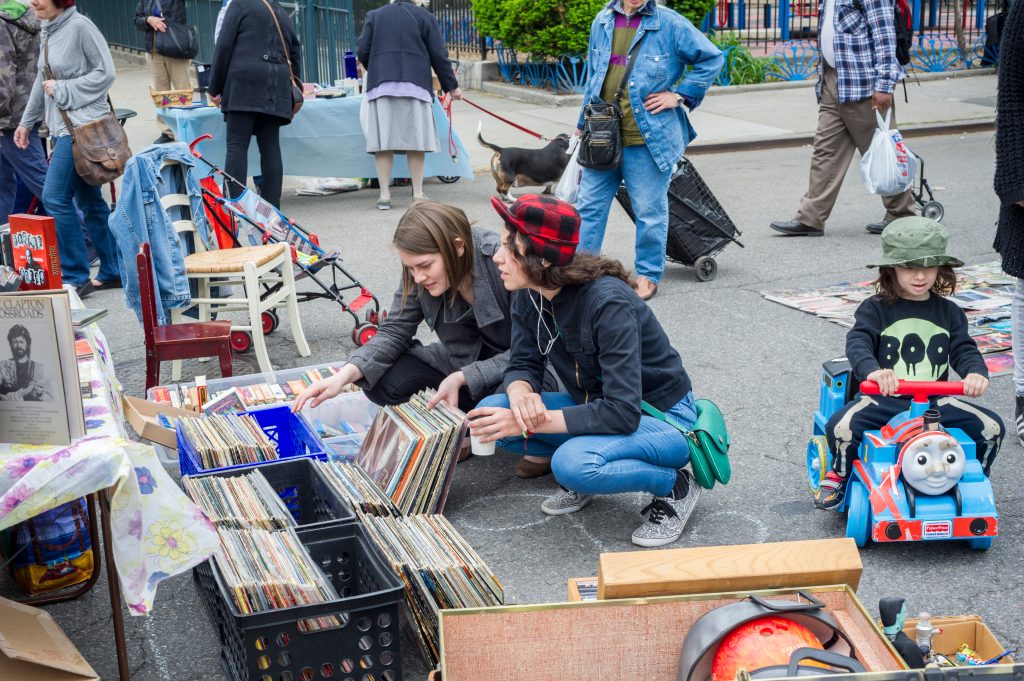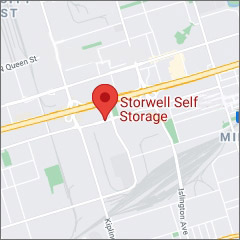A place for everything, and everything in its place.
A Totally-Not-Boring Blog About Storage
Tips and Tricks for Hosting a Successful Garage Sale
Table of Contents
- Set a date for your moving sale
- Check local rule and regulations for garage sales
- Identify and gather your inventory
- Set your prices
- Gather supplies for your garage sale
- Advertise your garage sale
- Make your garage easy to navigate
- Carry plenty of small bills
- Be prepared to haggle
- Offer deals as the day progresses
- Part ways with any leftovers
- Other general garage sale tips
- How Storwell can help with your next garage sale

Rummaging through a garage sale on a sunny Saturday afternoon looking for hidden treasures is a great way to pass the time. However, planning your own garage or yard sale can be a daunting task. Garage sales go by many names, like yard sale, estate sale, tag sale and moving sale, but regardless of what you call them, they all boil down to one point and that’s to sell your unwanted stuff for a profit. If you are relocating to a new home or just looking to downsize, hosting a garage sale is a great way to declutter, get organized and make a few extra dollars in the process. If you are planning on hosting your garage sale in the GTA, you should consider renting a storage unit in Mississauga, Scarborough or Etobicoke at a Storwell location. Self-storage can be a big help to free up space so you can assess the rest of your items and decide what is going on sale. If this is your first time hosting a garage sale, you might be a bit overwhelmed, but with some planning and preparation you will find yourself with less stuff, more cash, and a much easier move.
Set a date for your moving sale
If you are planning for a move, you should set the date for the moving sale three to four weeks before you relocate so you have time to donate or find places for unsold goods, and finish packing. In most areas, weekends are prime garage sale times. Having a multi-day sale or planning your sale at the same time as others in your neighbourhood may increase foot traffic. Talk to your neighbours to see if they’re interested in teaming up, and check your local news sites or community message boards to see if others are already advertising sale dates. Fridays and Saturdays are generally the best days for a garage sale. Consider holding one the first weekend of the month when many people get paid and have more discretionary cash. Set the date at least a month out to allow time to gather and price sale items.

Check local rule and regulations for garage sales
Some cities and towns have laws that impact garage sales. These typically aren’t a hassle. It’s just best to know them in advance so you can plan accordingly. For example, there may be regulations regarding sign placement or fire safety for neighborhood gatherings, or you may need a temporary permit to sell things in a residential area. To find out, just call your city hall and ask about rules and regulations for garage sales in your neighborhood. City of Toronto property owners can have up to two garage sales each year. Each garage sale can last two consecutive days and once the sale is over all signs and advertising must be removed.
Identify and gather your inventory
If you’re planning a garage sale, there’s no better opportunity to clean out your whole house. After all, the more items you have the greater chance you have to make profit. The most difficult part for most people is determining what they want to keep and what they want to get rid of. The best way to get through this is to be as methodical as possible. Grab a pen and paper and go room by room, making a list of everything you own. Consider furniture, appliances, kitchenware, decorations, clothes, toys, books, electronics, etc. With each item, ask yourself: How often do I use this? Do I need this? Do I really want this, or would it be better if I sold it? As you go through each room, set aside the things you are ready to part with. This will be your moving sale inventory. If your move is part of a major downsizing, you may want to rent a self-storage unit for sorting and organizing. This can serve as a temporary storage space while you comb through the contents of your home.
Set your prices

Once you have your inventory, it’s time to decide how much you want to ask for each item. Remember that people shopping at garage sales are looking for bargains. You likely won’t get top dollar for your goods, but that isn’t your main objective. Your goal is to minimize clutter, lighten your moving load, and earn a few extra dollars that can either go toward your moving expenses or new things and experiences once you’ve relocated. Try not to base your price on sentimental value. Your CD collection may have gotten you through the toughest years in high school; however, your neighbours likely won’t have the same assessment. Doing a quick Internet search can give you a sense of what people are willing to pay for used goods. For example, children’s clothes tend to run $1 to $3 for items in good condition. Adult clothes are usually $3 to $5, but can be more if the item still has a price tag or serves a special purpose, such as a business suit, uniform, evening gown, or costume. Books and music can go from 50 cents to $2, depending on condition.
Consider selling small-but-valuable things online. If you have collectibles, fine jewelry, or small electronics like classic iPods or video games, you may get better returns by selling them online through an auction site or classified listing. Consider the size and value of the item before going this route, since shipping costs for larger or low-value items may outweigh the benefits of an online sale.
Bundle small, similar items. It may be easier to make and process the sale of smaller items if you package them together. Instead of selling one paperback book for 25 cents, consider bundling a box of 10 romance novels for $2. You might also do this with toys, CDs, DVDs, games, baby clothes, t-shirts, and more. Likewise, if you have sets that could sell in pieces, offering a bulk discount might help you sell them all. For example, if you have a five-piece tea set, and you’re willing to sell each piece for $5, consider offering the whole set for $15 to $20 to incentivize a larger purchase.
Gather supplies for your garage sale
You’ll need just a few inexpensive things to set up and run your garage sale. Some things you will need are: labels for marking prices, poster paper and markers for creating signs, tables and chairs, sheets or tablecloths to display your items, boxes and bags for packaging sold goods, and drinks and snacks to keep yourself energized. If you’re planning to sell some items online, you may also want to stock up on envelopes, boxes, and shipping labels in advance.
Advertise your garage sale
Posters, lawn signs, and classified ads in the local newspaper are classic garage sale advertising options. You should certainly consider those, but nowadays you can do so much more to get the word out online. In addition to traditional advertising, consider creating a Facebook or other social media event page. Promote the event in your social media posts, and ask your friends to share it with their network. Online message boards, digital classified ads, and community calendars are all great options for promoting your sale to a broader audience. Any way you can get the word out is another opportunity for foot traffic. If you have sought-after items such as kids’ toys or clothes, specialty tools, craft supplies, or collectibles, make sure to note that in your social media posts and other advertisements. Always include your full address, days of the sale, and times. For online sites, request that your sale notice posts a day or two ahead of the sale and stays up through the last day. Promote your forms of payment in ads especially if you’ll accept credit cards and online payments.
Make your garage easy to navigate

Running garage sales is a lot like running retail stores, you want to make the buyer’s experience as pleasant and simple as possible. You can do this by tailoring the setup and general atmosphere of your garage sale. Displaying things on tables keeps the items at eye level, creating a more comfortable experience for customers. If you’re selling a lot of clothes, hang them up. Displaying them like this will make it easy for customers to sift through and will prevent you from having to repeatedly refold items throughout the day.
Carry plenty of small bills
It would be a shame to miss out on sales due to a lack of change. Go to the bank in advance and grab more small bills than you think you’ll need. If your garage sale stretches over multiple days, check on your stash and return to the bank before opening the next day. Nowadays people are using cash less and less frequently, so consider using an online payment system likes Square, Venmo, or PayPal to process transactions during your garage sale.
Be prepared to haggle
Many garage sale goers love to haggle, so be prepared to negotiate. Haggling is part of the process and can be used to your advantage. If you’re open to negotiating prices, you may mark your items a little higher to start, but don’t overdo it. When haggling with would-be buyers, don’t be overeager, and always have a firm minimum dollar amount in mind. If your prep work has paid off and the weather has cooperated, you can count on a steady flow of buyers to take stingy hagglers’ places. Reserve your negotiation strategies for the afternoon or the last day of a multiday sale.
Offer deals as the day progresses
If stuff isn’t selling as fast as you want it to, remember that the primary goal of any garage sale is to get rid of stuff, the cash is secondary. Sure, you’d like to make your money’s worth on your stuff, but most of that unsold stuff is going to get donated once the sale is over. It’s better to make a small sum off an item and have someone take that item off of your hands than hauling that same item away all by yourself. With an hour or two left in your sale, take a thick permanent marker and physically slash your prices. That way, shoppers can see just how much they’re saving.
Part ways with any leftovers
While it’s nice to score some extra cash, the main objective of a yard sale is clearing out all the things you don’t need. If you were willing to sell it for cheap, then it probably doesn’t have a place in your life anymore. Once you’ve had a successful garage sale, donate any leftover items to local causes. If you live in a high-traffic neighbourhood, you can also leave a “free” box near the sidewalk. No matter how you do it, just let those extra things go.
Other general garage sale tips
You will need at least two people to man the garage sale. One person will act as a cashier who can stay at a table with your cash box, and another who can meander, answer people’s questions, and generally serve as backup. Your “sales floor” it should be organized in a logical way making it easy to shop. Make sure all of your merchandise is clean, polished and ready for display. You want people to buy, so you have to put your best foot forward. Buy stickers that won’t damage your items, then tag each and every item in your sale with a price. That will help eliminate repeated questions about how much something costs. When designing the garage sale signage that you’ll place around your neighborhood, don’t forget to create a sandwich board and/or banner for your sale site. This will help capture people’s attention and draw them into your sale. Finally, don’t forget to mow your grass, sweep your porch, trim your bushes and trees and make the front of your home warm, welcoming, and generally approachable. Do your best to create a space where your neighbours and strangers will be comfortable shopping.
How Storwell can help with your next garage sale
Self-storage can be an invaluable tool to help with your garage sale. If the storage spaces in your home are filled to the brim it can be very difficult to declutter and find items you want to get rid of and sell at your garage sale. What you can do is store some items that you know you want to keep in your storage unit. Using Storwell for residential storage will help free up space so you can assess the rest of your items and decide what is going on sale. After your garage sale is finished you can remove your items from self-storage and bring them directly to your new home or keep your storage unit for additional storage space after you move. Each Storwell Self Storage facility has numerous safety features to give you the peace of mind that your items are being fully protected. Security features include: 24-hour camera surveillance, individually alarmed units, and passcode protected gate access. Storwell recognizes that the need for self-storage might come outside of office hours, which is why you will have access to your unit 24 hours a day, 7 days a week, 365 days a year.



